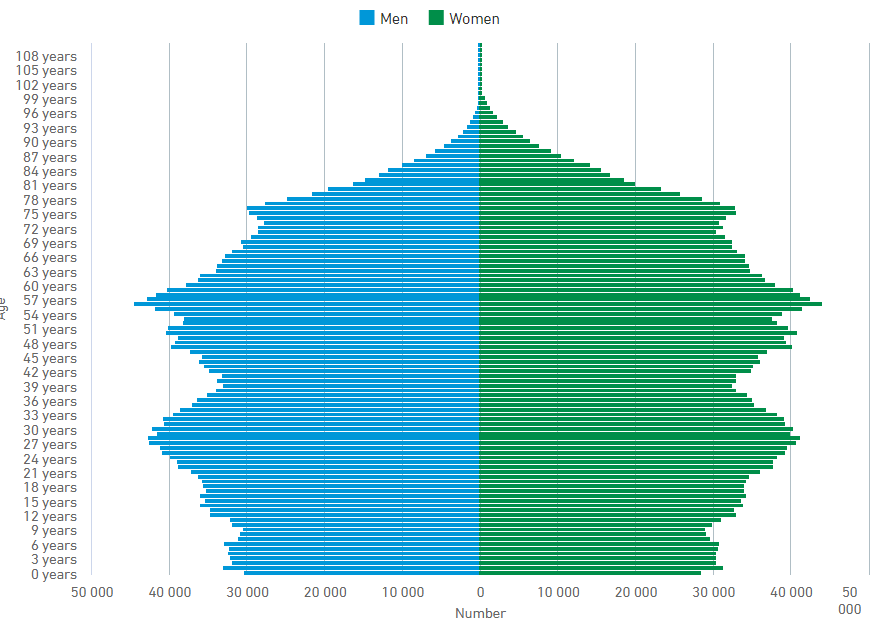Demographic situation
Area and number of inhabitants
Denmark covers 42,924 square kilometers and consists of the peninsula of Jutland and 443 islands. The number of inhabitants is 5,932,654 (2023).
Number of inhabitants 2000-2023, persons
| 2000 | 2005 | 2010 | 2015 | 2020 | 2023 | |
| Inhabitants | 5,330,020 | 5,411,405 | 5,534,738 | 5,659,715 | 5,822,763 | 5,932,654 |
Source: Statistics Denmark 2023.
The Kingdom of Denmark also comprises two self-governing territories:
- The Faroe Islands: 1,396 square kilometers with 53,653 inhabitants (2022);
- Greenland: 2,166,086 square kilometers with 56,609 inhabitants (2023).
Age distribution of the population
The life expectancy for men is 79.4 years and 83.1 years for women (2021/2022).
Population pyramid 2023, persons

Source: Statistics Denmark 2023.
The age distribution of the population since 2000 is shown in the table below. The percentage of people aged 0-15 years and 16-66 years has decreased since 2000, while the percentage of people aged 66+ years has increased.
Age distribution 2000-2023, pct.
| 2000 | 2005 | 2010 | 2015 | 2020 | 2023 | |
| 0-15 years | 19 % | 20 % | 19 % | 18 % | 18 % | 17 % |
| 16-66 years | 67 % | 66 % | 66 % | 64 % | 64 % | 64 % |
| 66+ years | 14 % | 14 % | 15 % | 18 % | 19 % | 19 % |
Source: Statistics Denmark 2023.
The table below shows the dependency ratio from 2000-2022 and shows that the dependency ratio has increased since 2000. This indicates that the number of dependents – people younger than 15 years or older than 64 years – are increasing relative to the number of people providing this support – people between the ages 15 and 64.
Age dependency ratio 2000-2022, pct.
| 2000 | 2005 | 2010 | 2015 | 2020 | 2022 | |
| Dependency ratio | 50 % | 51 % | 53 % | 55 % | 57 % | 58 % |
Source: The World Bank 2023.
Employment and unemployment
The table below shows the unemployment rate from 2000-2022.
Unemployment rate 2000-2022, pct.
| 2000 | 2005 | 2010 | 2015 | 2020 | 2022 | |
| Net unemployment rate | 4.9 % | 5.1 % | 4.2 % | 3.8 % | 4.2 % | 2.2 % |
Source: Statistics Denmark 2023.
Migration
In July 2022, immigrants and descendants numbered 886,748 or 15 percent of the Danish population. In total, ten per cent of the population were immigrants and descendants of non-Western origin, while five percent of the population were immigrants and descendants of Western origin.
The three largest groups of immigrants and descendants are persons originating from Türkiye (seven percent), Poland (six percent) and Syria (five percent).
The table below shows the long-term migration to and from Denmark in the period 2000-2020.
Migration to and from Denmark 2000-2020, persons
| 2000 | 2005 | 2010 | 2015 | 2020 | |
| Immigration | 41,996 | 39,694 | 51,944 | 78,502 | 57,230 |
| Emigration | 30,959 | 33,893 | 41,759 | 44,625 | 53,822 |
| Net migration | 11,037 | 5,801 | 10,185 | 33,867 | 3,408 |
Source: The Ministry of Immigration and Integration 2022.
Languages
The official language is Danish, which is used in legislation and public administration. This is also the language of instruction in schools and educational institutions. Furthermore, the languages of instruction in the Faroe Islands and Greenland are Faroese and Greenlandic respectively.
In connection with the European Charter for Regional or Minority Languages of 5 November 1992, Denmark identified German as a minority language. The German minority comprises approximately 15,000 people who reside mainly in southern Jutland.
English is a compulsory subject in primary and lower secondary education from form level 1 and in upper secondary education. German or French is a compulsory subject in primary and lower secondary education from form level 5 and in upper secondary education. Most higher education institutions offer courses and programmes in English.
Religions
Freedom of religion is a right protected in the Danish constitution. In 2023, 72.1 percent of the population is registered members of the Evangelical Lutheran Church of Denmark.
In primary and lower secondary education, religion is a compulsory subject for pupils in all form levels, except the form in which preparation for confirmation takes place. The pupils learn about philosophy of life and ethics, biblical tales, Christianity and non-Christian religions.
In upper secondary education, religion is a compulsory subject in the Higher General Examination Programme (STX) and the Higher Preparatory Examination Programme (hf). The students learn about Christianity as well as other religions such as Islam, Buddhism, Hinduism and Judaism.
References
Bibliography
Education Guide, 2023: Religion C – stx (Religion C - stx). [Accessed 14 September 2023]
Eurostat, 2018: Glossary: Total-age dependency ratio. [Accessed 14 September 2023]
Ministry of Culture, 2023: The European Charter for Regional or Minority Languages: Denmark's Sixth Periodic Report. [Accessed 14 September 2023]
Ministry of Immigration and Integration, 2022: International Migration - Denmark. [Accessed 14 September 2023]
Nordic Co-operation, 2023: Facts about the Faroe Islands. [Accessed 14 September 2023]
Statistics Denmark (Danmarks Statistik), 2023: Average lifespan (Middellevetid). [Accessed 14 September 2023]
Statistics Denmark (Danmarks Statistik), 2023: Members of the Evangelical Lutheran Church in Denmark (Medlemmer af folkekirken). [Accessed 14 September 2023]
Statistics Denmark, 2023: Population figures. [Accessed 14 September 2023]
Statistics Greenland, 2023: Population. [Accessed 14 September 2023]
